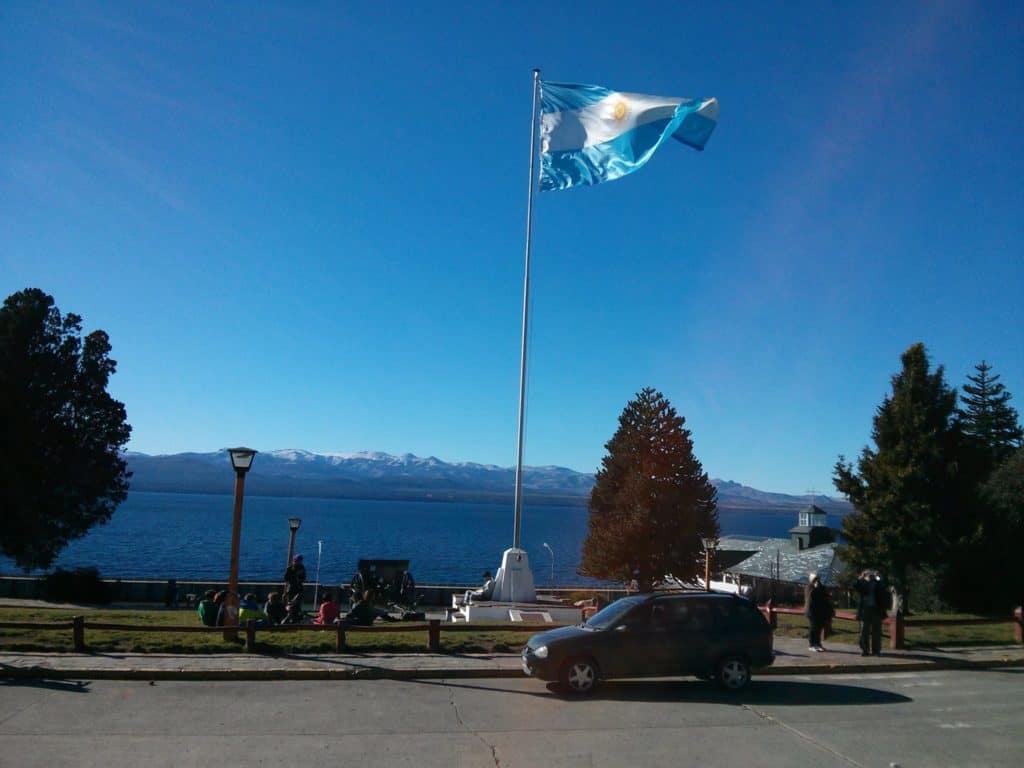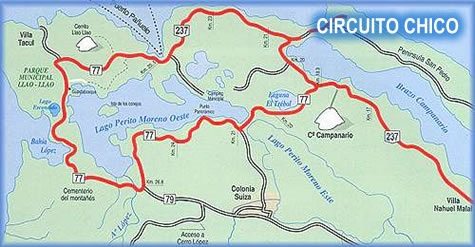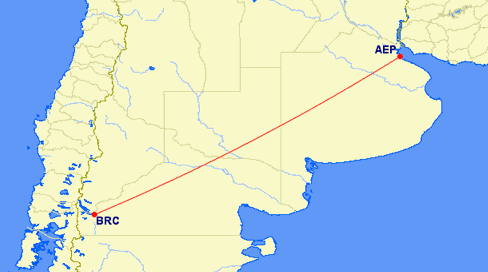MileValue is part of an affiliate sales network and receives compensation for sending traffic to partner sites, such as CreditCards.com. This compensation may impact how and where links appear on this site. This site does not include all financial companies or all available financial offers. Terms apply to American Express benefits and offers. Enrollment may be required for select American Express benefits and offers. Visit americanexpress.com to learn more.
Note: Some of the offers mentioned below may have changed or are no longer be available. You can view current offers here. All values of Membership Rewards are assigned based on the assumption, experience and opinions of the MileValue team and represent an estimate and not an actual value of points. Estimated value is not a fixed value and may not be the typical value enjoyed by card members.
San Carlos de Bariloche, Argentina is a mountain town in the Lake District of Patagoina, located about 50km from the Chilean border. It sits right on the edge of the Parque Nacional Nahuel Huapi, drawing visitors from all over to admire the spectacular lake and mountain views.
Scott and I recently decided to use Avios to fly LAN from Buenos Aires to Bariloche for five days. The southern hemisphere has just entered fall. In Patagonia, that means cold weather quickly. Because of this, we wanted to get there as soon as possible to enjoy what little good weather remained (before ski season’s “good” weather.) We knew that the town would be relatively empty as Bariloche’s two peak seasons are the summer and the winter.
For the wonders of Patagonia, keep reading.
Sleeping
We spent all five nights at the uninspiringly named Hostel Inn (Salta 309, Bariloche, Argentina). Scott picked it using his hostel picking methods laid out in How I Pick a Hostel.
I really enjoyed the hostel. The main room had couches for lounging, long tables, free WiFi, and a small breakfast every morning (bread with jam and dulce de leche, cereal, coffee, juice, and tea.) Our private double room cost $30 per night and included a private bathroom.
The best feature of Hostel Inn is the large deck off of its main social area with benches and lounge chairs that you can relax in while admiring the view of Lago Nahuel Huapi:
We were drawn to the hostel by the deck, but we spent so little time at the hostel that we didn’t spend much time on the deck. I imagine that it is an awesome option during the summer months.
The staff is incredibly knowledgeable about the area and was constantly giving us tips about places to go and things to do. One great service offered is that you can purchase tours right at the front desk of the hostel–they call the tour company to check availability and arrange everything–for the same price as any travel agency in town. If you don’t speak great Spanish, this can be really convenient to make sure that you are getting what you want.
Day 1—Friday
We took a two hour flight on a beautiful Friday morning from the domestic Buenos Aires airport (Aeroparque, AEP) to Bariloche. After checking in to our hostel, we set out to explore Centro Civico and the center of Bariloche in the early afternoon.
Downtown Bariloche is small and easily walkable in an afternoon. We started at the Centro Civico, a plaza in the center of the city.

The Lake District of Patagonia is known for its stone and wood architecture, clearly visible around the central plaza.

We stopped in at Museo de la Patagonia, which is right in the Centro Civico and is filled with historical artifacts from Patagoina, as well as displays on the history and natural habitat in the area. It is small, only requiring 45 minutes to walk through, and gives you a nice background on Bariloche and the northern part of Patagonia for 15 pesos. I thought the historical part was less interesting than the downstairs sections on native flora and fauna. The displays are in Spanish.
The town of Bariloche is similar to most ski towns in terms of its architecture and tourist-geared offerings. We walked along Avenue Juan Manuel de Rosas, the street that runs along the Lago Nahuel Huapi waterfront, and took in the sights. There is a beautiful cathedral located on 12 de Octubre and Beschtedt that overlooks the lake–the views alone make it worth a stop.
If you visit Bariloche, definitely don’t pass on visiting one (or two, or five) of their incredible chocolate shops! The town is known in part for their decadent Belgian chocolates, so we stopped at a chocolate factory to taste some goodies. There is one on nearly every corner! The one we chose, Franton, had a long, glass-walled hallway where you could watch the chocolateiers work. The chocolates con dulce de leche y almendras were my favorite and are highly recommended by this self-proclaimed connoisseur.

For dinner we went to La Trattoria de la Familia Bianchi, an Italian spot that is Lonely Planet’s top restaurant choice in Bariloche. They have some delicious pastas and risottos, along with steak that you would expect from any Argentine restaurant.
We ordered a capresse opener, chicken/mushroom risotto and chicken ravioli. Everything was so delicious we forgot to photograph it until we are almost done. The menu had an extensive selection of local beers (El Bolson Frambuesa is a good raspberry flavored one) and wines.
Day 2—Saturday
On Saturday, we tapped into our outdoorsy side by biking the 30km Circuito Chico loop that weaves through several lakes just west of Bariloche.

After grabbing a cab out of town, we rented bikes from Circuito Chico Adventures for 120 pesos per person. They open at 10:30AM, and you must return your bikes back to them 6:30PM or you risk incurring a late fee. The staff is extremely helpful, mapping out the route for us and pointing out different detours and lookouts. The bikes and helmets were in excellent condition and neon vests were provided.
At no point is the circuit flat or straight as it meanders through through the lakes as a series of curving uphills and downhills. The ride is manageable to do if you’re either young or in good shape. Both would be a bonus. Keep in mind that Bariloche is at 3,000 feet above sea level, so the hills can cause your thighs to burn. When we got tired–which happened on many of the uphill stretches–we simply hopped off our bikes and walked. Take it easy and watch your speed on the downhills as you don’t want to drift across the center lines going around blind curves.
The sights are absolutely incredible along the Circuito. Every turn offers another breathtaking view of towering mountains, reflective lakes, and dense forest. Spending the whole day active outside was a treat, and the ride was my favorite activity on the trip.
We did not have the best weather on our ride–it sprinkled intermittently and it was cold on the downhills–but that didn’t prevent us from admiring the awesomeness that is the size of the lakes and mountains along the route.
We took our first detour by leaving the main road and biking 3km on unpaved road to Colonia Suiza for lunch. This little town has only a few shops and restaurants and is a great way to see a little more of the area surrounding Bariloche.
The other detour along the loop recommended to us by a MileValue reader was afternoon tea at Hotel Llao-Llao, a famous upscale Argentine hotel with an incredible view of Lago P. Moreno Oeste.

Upon arrival, we were taken in to their tea room which overlooks the lake and mountains in the distance. You can have a full tea or order a la carte; the full tea service is available for 360 pesos for two people. The full tea services consists of plates of sandwiches, scones, and an assortment (I think there were about eight!) desserts. You need to call Llao-Llao ahead to make a reservation—we called from the bike rental shop that morning. Tea at Llao-Llao is definitely a memorable experience. Even if you don’t bike the Circuito, you can easily drive to the hotel or take Bus 20 from Bariloche to have the experience.

The whole loop took us about six hours, including stops for pictures, lunch, tea, and breaks. While many people who visit Bariloche simply rent a car and drive the Circuito, if health permits I highly recommend the open-air bike tour.
After heading back to the hostel to clean up, we went to dinner at Dias de Zapata, a great Mexican/Tex-Mex spot in Bariloche. I think this was some of the best “traditional” Mexican food I’ve had since coming to Argentina. They offer standard, but well-executed, items like quesadillas, fajitas, tacos, and imported Corona. Tip: In Argentina, nachos are plain tortilla chips. If you want Mexican/American-style nachos, order nachos con queso.
Concluded in Part 2.










Given the de valution of the peso vs. the $USD, it sounds like Argentina would be a good deal destination .
It’s cheap, but the constantly changing exchange rate is a bit of an annoyance. You have to change money frequently, so that you avoid holding quickly devaluing pesos.
Any tips on award travel to Igassu from Buenos Aires ? Avios nor united seems to have partners that fly that route.I’m looking for EZE-IGR and IGU-GIG.
It is not EZE to IGR (thankfully since EZE is far from the city). The flights leave the domestic Buenos Aires airport (AEP). The flights are flown by Aerolineas Argentinas and LAN and can be booked with Delta miles and Avios respectively. The flight in Brazil will be on TAM and booked with United or US Airways miles.
Thanks !..appreciate the info. BA and United dont show up anything. Will mostly have to call.
[…] Read Part 1 First. […]
Scott
I am spending 4 days in BA next week , business class LAN to EZE, i have 5 more days to fill, being winter there do you recommend Bariloche or Iguaza Falls IGR? Will truly appreciate your opinion. Will be travelling with my husband and 12 year old daughters
I am right around Iguazu at the moment. The weather is about 75 degrees, but it has been rainy. In Bariloche right now, it’s high of 50, low of 35. The fun stuff in Bariloche is more physically demanding, but there’s a lot more of it. Iguazu is a two day trip if all you will see is the Arg side of the falls. It really depends on your weather preferences and weather you like to look at beauty (Iguazu) or do beauty (hiking, biking in Bariloche).
thank you Scott. Is it possible to cross to the Brazilian side of the falls
without paying for a Visa for a short tour?
[…] Part 1 focused on Buenos Aires. Part 2 will focus on three days in two other places: Iguazu Falls and Tigre. (Also check out a Trip Report on the Lake District of Patagonia.) […]
[…] Biking in the Lake District of Patagonia in Bariloche, Argentina […]
[…] Biking in the Lake District of Patagonia in Bariloche, Argentina […]
[…] research indicates they might have crossed Lago Nahuel Huapi, which I actually have visited already! Oops! I still want to see more of Patagonia, […]
[…] Bariloche Trip Report […]
[…] For instance, March is a fantastic month in Argentina, and you can book an award to Buenos Aires or Bariloche every March for 10,000 fewer American Airlines miles than if you travel in July, a worse time to […]
[…] Trip Report Part 1 and Part […]